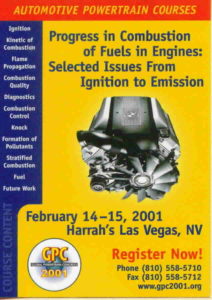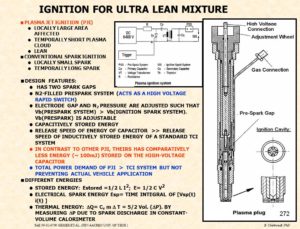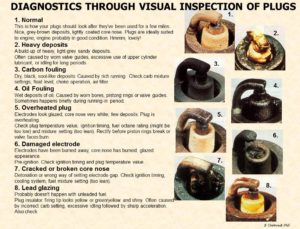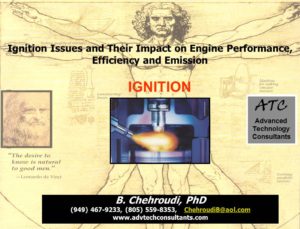Ignition Technologies and Advanced Diagnostics
(3-day version is described here. However, a 2-day version is also available and can be customized)
Combustion (or burning) is a fast self-sustaining chemical reaction that releases a large amount of heat. Burning candles, forest fires, log fires, the natural gas burning in home furnaces, and the burning of gasoline in internal combustion engines are all examples of common combustion processes. Many of critical technologies today employ combustion as the key element of their  operation. The objective is to convert the stored chemical energy of the "fuels" into thermal energy. To achieve this, three things must normally be present: a fuel, an oxidizer, and an ignition source. Today, nearly 85% of the world's energy is produced through combustion and hence is vital to our way of life. Therefore, it poses great challenge to maintaining a healthy environment. Improved understanding and control of ignition and thereby combustion will assist us in dealing with the problems of pollutants formation, performance, and fuel economy. To this end, it is crucial for engine design engineers to be aware of basic knowledge and recent advances in combustion-initiation (ignition) issues to more intelligently evaluate and harness their potentials.
operation. The objective is to convert the stored chemical energy of the "fuels" into thermal energy. To achieve this, three things must normally be present: a fuel, an oxidizer, and an ignition source. Today, nearly 85% of the world's energy is produced through combustion and hence is vital to our way of life. Therefore, it poses great challenge to maintaining a healthy environment. Improved understanding and control of ignition and thereby combustion will assist us in dealing with the problems of pollutants formation, performance, and fuel economy. To this end, it is crucial for engine design engineers to be aware of basic knowledge and recent advances in combustion-initiation (ignition) issues to more intelligently evaluate and harness their potentials.
The thermodynamic and fluid mechanical states of the unburned charge near and at the time of the spark strongly affect the quality of the combustion and therefore the emission of the pollutants from the engine. The engine performance and drivability are also strongly affected by a weak ignition. The so-called cyclic variability, which affects and bounds the lean and knock limits of an engine design is to a great degree influenced by the ignition system. Equally important, the ignition system can and is being used to provide local in-cylinder information on air-fuel ratio, misfire, knock, and mass fraction burned in each individual cylinder. Hence, great potential exists for applications of this information to attain a more fuel efficient and environmentally compatible engine.
This seminar starts with a concise yet effective review of the combustion issues and terminology in engine to establish a uniform knowledge base. Then the focus is turned on the fundamental knowledge on charge ignition. Commonly-used ignition systems are described next followed by the explanation of four phases of the spark ignition. Effects of key ignition variables on performance and emission of pollutants are described in details. After the introduction of some alternative ignition methods, a comprehensive presentation on engine diagnostic and control opportunities through use of ignition system is given. The ignition of ultra lean mixtures is fully covered next. Throughout the seminar emphasis is put on effects of ignition system on engine performance, efficiency and emission of harmful pollutants. Engineers in other areas than automotive will find this seminar very informative and useful for their ignition problems.
Benefits of Attending: 
Upon completion of this seminar, you will:
- Gain a comprehensive understanding of the important processes in ignition and its relation to engine performance, efficiency, and emission
- Receive a concise yet effective overview of the combustion in internal combustion engine
- Develop the background and necessary foundation to educate yourself beyond the depth and topics covered
- Learn ignition strategies for reduction of pollutant species from engine
- Understand the effects of ignition system design and engine operating conditions on combustion and emission
- Be able to communicate effectively with engineers working on ignition, combustion, and emission aspects in your company
- Grasp the technology and the logic behind the current and future ignition-based engine diagnostics
- Effectively contribute to the design of critical components such as combustion chambers and exhaust systems
- Identify key design components of an ignition system for optimum combustion chamber design and low engine emission of pollutants.
Who Should Attend:
This seminar will be especially valuable for engineers, technical and project managers, researchers, and academicians involved in ignition and combustion/emission aspects of the combustion engines. Currently, the design of many components in these engines are affected by combustion and emission control measures to meet customer’s, federal and local government’s demands and regulations. Therefore, engineers working on the design of components for high efficiency and performance of combustion engines as well as those directly and indirectly involved in ignition and emission reduction strategies will highly benefit from this seminar. Additionally, this seminar provides adequate background for engineers and managers in contact with those directly involved in ignition, combustion, and emission issues and will prepare them for a more efficient and intelligent communication style in an interdisciplinary environment. Engineers desiring to expand their understanding of ignition and its impact on combustion and emissions from engines will highly benefit by attending this seminar.
emission reduction strategies will highly benefit from this seminar. Additionally, this seminar provides adequate background for engineers and managers in contact with those directly involved in ignition, combustion, and emission issues and will prepare them for a more efficient and intelligent communication style in an interdisciplinary environment. Engineers desiring to expand their understanding of ignition and its impact on combustion and emissions from engines will highly benefit by attending this seminar.
How to Arrange for a Presentation:
Due to ATC's low overhead, direct-contact clients are offered a competitive and cost-effective package. Individuals interested in these seminars should contact Advanced Technology Consultants (ATC) directly. Alternatively, this seminar (prepared by the ATC and delivered by a award-winning ATC consultant) are also sponsored by the Society of Automotive Engineers (www.SAE.org). Click here on IGNITION to see the SAE page for this seminar.
Electronic and hard copies of the seminar materials can be purchased and are only available through ATC. Contact ATC for price and shipping.
NOTE: Professionally-prepared "audio-video Powerpoint-type presentations" of these seminars are available for purchase by companies. Each slide is presented with a clear audio by the consultant, describing the subject, while a digital pointer guides the audience to where the attention is to be focused. Companies can put such audio-video presentations on their intranet to be used by their employees. It is a cost effective way of approaching professional training, which also contributes towards R&D, design, and intelligent new product development efforts. Presentations are updated every year at a fraction of the original cost. For a sample presentation click on the word "IGNITION" in the picture to get a feel of how  information is transferred (High-speed internet access is recommended. Otherwise, download may take a few more minutes). The actual copy sold is of high resolution with high quality sound. For more details and pricing please contact ATC.
information is transferred (High-speed internet access is recommended. Otherwise, download may take a few more minutes). The actual copy sold is of high resolution with high quality sound. For more details and pricing please contact ATC.
TABLE OF CONTENTS (3-day version)
Day one
- Concise Treatment of combustion in spark ignition (SI) engines
- Cylinder pressure traces
- MBT and ignition timing
- Effects of ignition timing on efficiency, performance, HC and NOx emissions
- Flame visualization
- Propagation
- Laminar burning speed
- Effects of some parameters
- Turbulence
- Swirl & Tumble
- Combustion characterization and heat release rate
- Cyclic variability and "COV"
- Cylinder-to-cylinder variability
- Ignition fundamentals

- Minimum ignition energy (MIE)
- Effects of flow and turbulence
- Visualization
- Spark igition
- Function of ignition system
- Ignition systems commonly used
- Inductive coil ignition system
- Mechanical
- Transistorized
- Capacitive discharge system
- Anatomy of a spark plug (SP)
- Cold and hot SP
- Effects of some parameters
- Comparison of different ignition systems
- Detailed operation of an ignition system (Toyota)
- Inductive coil ignition system
- What determines the amount of ignition energy?
Day two
- Four phases of spark ignition
- Pre-breakdown phase
- Breakdown phase
- Arc phase
- Glow discharge
- Energy transfer efficiency
- Effects of some key parameters
- Higher power and/or energy
- Longer duration discharge
- Spark plug orientation
- Multiple spark plug
- Different spark plug designs
- Self-cleaning spark plugs
- An advanced production ignition system
- Visual inspection of plugs for diagnostics
Day Three
- Alternative ignition methods and their impacts o efficiency and emissions
- Corona ignition system
- Plasma-jet ignition system
- Flame-jet ignition system
- Activated radical (AR) ignition
- Laser ignition in engines
- Light-activated volumetrically-distributed ignition
- Others
- Diagnostics and control opportunities
- Use of spark plug voltage for monitoring combuston
- Spark spectroscopy
- Ionization measurement using spark plug for monitoring:
- Cylinder pressure
- A/F ratio
- Knock
- Misfire
- Mass fraction burned
- Ignition systems for highly-diluted mixtures
- Flame jet ignition system design issues
- Different electrode designs
- Plasma jet ignition
- Conclusions
